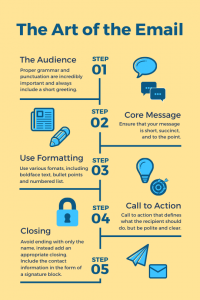By Communication Consultant Carolyn Reagan (Accounting, ’23)

Email continues to hold a place of dominance in school- and workplace communication. For many years to come, mails and proper email etiquette will continue to be an integral part of your success. We want to remind you of a few important considerations when writing your emails:
- Audience: There are a number of different types of people that you may encounter when sending emails: your professor, your group project partner, or your club members. With professors, managers, and new contacts, formality is the best approach. For more casual relationships, there is no need for over professionalism; however, it is important to err on the side of caution. No matter who you are emailing, proper grammar and punctuation are incredibly important.
- Greeting: Always be sure to include a short greeting, such as “I hope you are well,” or “I hope you are having a great Tuesday!” before writing your core message. Doing so helps establish rapport with your recipient.
- Core message: Due to the nature of emails, keeping your message as short as possible is important. It is best to ensure that your message is short, succinct, and to the point. Be certain that your core message is immediately clear.
- Use formatting: Boldface text can bring attention to key ideas and information. Bullet points make details more easily readable. When describing a process or sequenced information, use a numbered list.
- Call to action: Most emails seek an outcome, such as moving a process to the next step or sending necessary information. Effective emails end with a call to action that defines what the recipient should do. Begin a call to action politely, and be clear about what you need. For example: “Would you please send me the numbers for registration cross listed with site hits on the survey?” or “Thank you in advance for sending your RSVP to the meeting as soon as possible.”
- Closing: Be sure to include a closing. Depending on the nature of the email, there are a number of suitable ways to end an email: “Regards,” “Sincerely,” or “Best.” Unless the email is very casual, you want to avoid ending it with just your name.
- Signature block: A professional email should always include your contact information in the form of a signature block at the end of your message. Some firms mandate a style for signature blocks, so when you are a working professional, be sure you know your company’s email etiquette. While in school, your signature block might look like this:
Your Name
Accounting and Business Information Systems
Lehigh University College of Business class of ____
(865) 555-2021
____.linkedin.com
Get information and resources about our center at The Philip Rauch Center for Business Communication.
